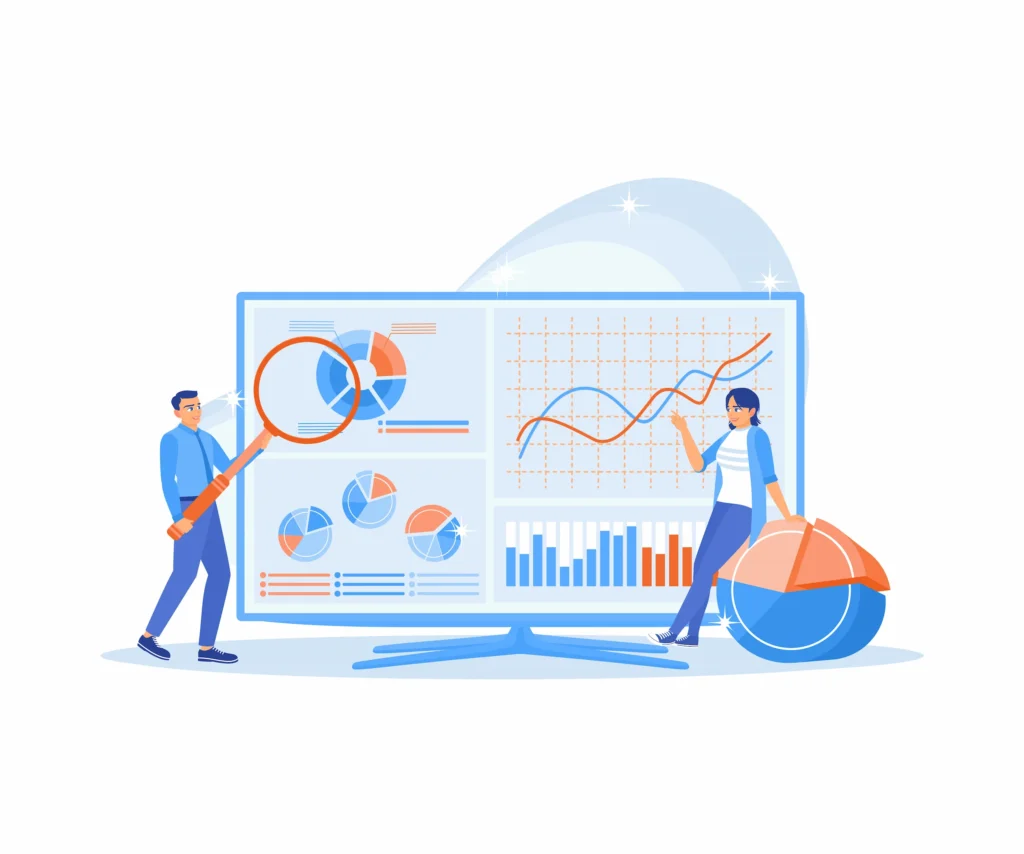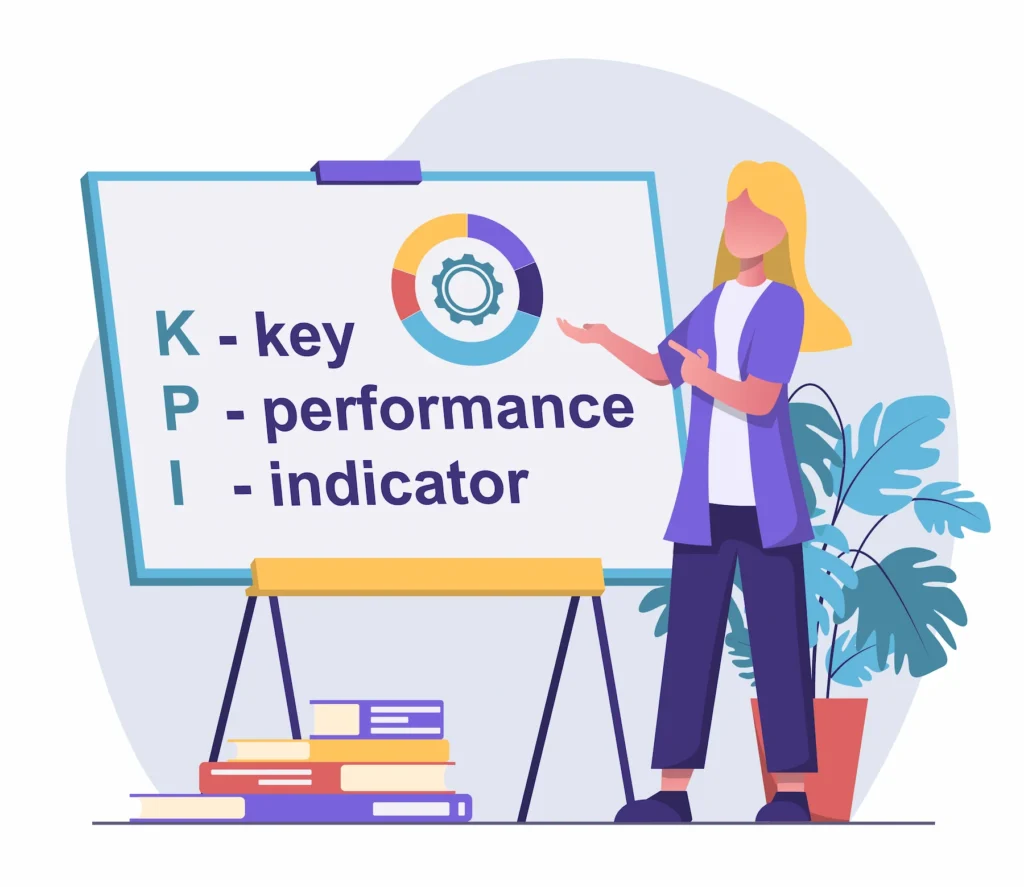What are Key Performance Indicators (KPIs)?

Key Performance Indicators (KPIs) are measurable values that indicate how effectively an individual, team, or organization is achieving its objectives. They serve as a critical tool for tracking progress, assessing success, and identifying areas for improvement. In today’s data-driven world, KPIs have become indispensable for businesses aiming to achieve strategic goals and maintain competitiveness.
What is a Key Performance Indicator (KPI) and How is it Different from a Metric?
KPIs are often confused with metrics, but they are not the same. While metrics represent any quantifiable data point, KPIs are specific metrics that are directly tied to strategic objectives. For example, “number of website visitors” is a metric, but “percentage increase in website traffic to achieve a 20% annual growth” is a KPI.
What sets KPIs apart is their actionable nature. They are not just numbers but benchmarks that guide decision-making and drive actions toward achieving desired outcomes. Unlike generic metrics, KPIs are carefully selected to ensure they align with an organization’s goals, making them more meaningful and impactful.

Why are KPIs Important? Benefits and Advantages
KPIs play a pivotal role in organizational success for several reasons. Firstly, they provide a clear understanding of performance by breaking down complex processes into measurable components. This clarity allows organizations to focus on what matters most and streamline their efforts.
Additionally, KPIs improve accountability by assigning measurable targets to teams and individuals. When everyone knows what’s expected, they are more likely to stay motivated and aligned. Moreover, KPIs offer invaluable insights for decision-making, enabling leaders to identify what’s working and what isn’t. They also foster a culture of continuous improvement by tracking progress over time and encouraging teams to strive for better results.
Common Types of KPIs and Their Applications
Different types of KPIs serve different purposes. Let’s explore some common categories:
- Financial KPIs: These include profit margins, revenue growth, and cost savings. They are crucial for monitoring an organization’s financial health.
- Operational KPIs: Focused on efficiency and productivity, examples include production costs, on-time delivery rates, and resource utilization.
- Customer KPIs: Metrics like customer satisfaction scores, Net Promoter Scores (NPS), and retention rates measure how well a company meets customer needs.
Each type of KPI has specific applications depending on the organizational context, but their collective aim is to drive performance improvement.
What Makes a Good KPI? Characteristics and Best Practices
A good KPI is like a lighthouse—it provides clear direction and helps avoid pitfalls. To ensure KPIs are effective, they must be:
- Specific and Measurable: Clearly defined and easy to quantify.
- Aligned with Goals: Directly tied to strategic objectives.
- Actionable: Capable of driving meaningful change.
- Time-Bound: Set within a defined timeframe to ensure accountability.
Best practices for setting KPIs include involving key stakeholders in the design process, regularly reviewing their relevance, and avoiding the temptation to track too many metrics at once.
How to Define and Set Up Effective KPIs
Defining effective KPIs starts with a deep understanding of organizational goals. Begin by identifying the outcomes you want to achieve and then break them down into measurable targets. For instance, if your goal is to increase customer retention, a possible KPI could be the “percentage of repeat customers in a year.”
Next, use tools like SMART criteria (Specific, Measurable, Achievable, Relevant, Time-Bound) to refine your KPIs. Ensure that each KPI aligns with your team’s capabilities and available resources. Lastly, leverage technology, such as KPI dashboards and data analytics software, to streamline tracking and reporting processes.
Practical Examples of KPIs Across Different Departments
Different departments have distinct priorities and therefore require unique KPIs:
- Marketing KPIs: Click-through rates, customer acquisition costs, and social media engagement.
- Sales and Retail KPIs: Revenue per customer, average transaction value, and sales growth rate.
- Operations KPIs: Downtime, order fulfillment accuracy, and inventory turnover.
- Human Resources KPIs: Employee turnover, absenteeism rates, and employee satisfaction scores.
- Product Management KPIs: Product adoption rates, defect rates, and cost of delay.
Each KPI serves as a navigational tool for department-specific success.

How to Track KPIs Effectively
Tracking KPIs effectively requires a structured approach and the right tools. Here’s how you can do it:
1. Select the Right Tools: The use of specialized tools like dashboards and analytics software simplifies the process. Tools like Google Analytics, Tableau, and Microsoft Power BI provide real-time insights and customizable reports tailored to your KPIs.
2. Establish Regular Reviews: It’s not enough to set KPIs and forget about them. Schedule periodic reviews—daily, weekly, or monthly—depending on the KPI’s importance and timeline. This ensures that you can quickly identify trends, anomalies, or areas requiring intervention.
3. Ensure Data Accuracy: Inaccurate data can lead to misleading conclusions. Implement robust data collection and validation methods to ensure reliability. Assign responsibility to specific team members to maintain data integrity.
4. Act on Insights: Tracking KPIs without taking action is like having a compass and never moving. Analyze trends, compare them to your benchmarks, and make informed decisions to drive progress.
How to Present KPIs and Create Effective Reports
Presenting KPIs in an understandable and engaging format is crucial for stakeholder buy-in. Here’s how to do it:
1. Use Visualizations: People process visuals faster than text. Utilize bar charts, line graphs, and pie charts to make data more accessible. Tools like Excel or data visualization software can help transform raw numbers into compelling visuals.
2. Simplify Data: Avoid overwhelming your audience with too much information. Focus on the most critical KPIs and present them concisely. Use summaries and key takeaways to highlight the most relevant insights.
3. Customize for the Audience: Tailor reports based on your audience. For executives, focus on high-level trends and business impact. For operational teams, provide detailed insights that guide day-to-day actions.
4. Leverage Dashboards: Real-time dashboards allow stakeholders to track progress independently.
The Pros and Cons of Using KPIs
Like any tool, KPIs come with their own set of advantages and drawbacks:
Pros:
- Focus and Clarity: KPIs help teams prioritize efforts and stay aligned with objectives.
- Improved Accountability: Assigning measurable targets ensures that everyone knows their responsibilities.
- Enhanced Decision-Making: With KPIs, leaders can make data-driven decisions, reducing guesswork.
- Motivation and Engagement: Clear benchmarks inspire individuals and teams to achieve more.
Cons:
- Overemphasis on Numbers: Solely focusing on KPIs can overlook qualitative factors like team morale or customer sentiment.
- Risk of Misinterpretation: Without proper context, KPI data can be misleading.
- Time-Intensive Setup: Establishing and maintaining KPIs requires significant time and resources.
The Limitations of KPIs
While KPIs are powerful tools, they are not without limitations:
1. Narrow Focus: KPIs often focus on specific aspects of performance, potentially overlooking broader trends or external factors. For example, an organization may achieve a financial KPI while harming customer satisfaction.
2. Context Dependency: KPIs can vary drastically between industries, companies, and even teams. A KPI that works well for one organization may not be relevant for another, making them less universally applicable.
3. Difficulty in Measuring Intangible Metrics: Not all success factors are easily quantifiable. For instance, gauging the impact of company culture or employee creativity may not fit into a typical KPI framework.
4. Risk of Short-Term Thinking: A fixation on KPIs might lead teams to prioritize short-term wins over long-term growth and innovation.
To mitigate these limitations, it’s essential to combine KPIs with qualitative assessments and strategic oversight.
Key Performance Indicators (KPIs) are indispensable tools for measuring and driving organizational success. From setting clear objectives to enabling data-driven decisions, they empower businesses to stay focused and competitive. However, like any tool, they must be used strategically to avoid pitfalls like narrow focus or over-reliance.
By selecting the right KPIs, tracking them effectively, and presenting them clearly, organizations can unlock their full potential. Remember, KPIs are not just numbers—they are the compass guiding your journey toward success. Use them wisely, and don’t hesitate to adapt as your goals and environment evolve.

